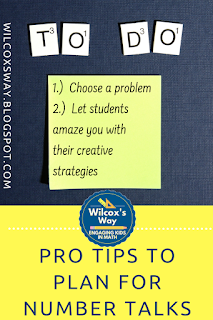If you're ready to start with number talks but not sure how to get started, here are a few things to consider.
- Choose a problem that will work for your students. Personally, I usually start with a two-digit by one-digit multiplication problem such as 13 x 9. I like that it allows lots of strategies. I also like that my students can do this problem, but yet they still have a feeling of accomplishment when they do it in their head. If you think your students aren't ready for something like this right away, that's fine! I've used easier problems as well, such as 6 x 12 or even 9 x 8. If you choose a problem where some students just "know" the answer, tell them to find a strategy as if they don't know the answer.
- Think of several ways to find the answer. As you are thinking of different strategies, decide what mathematical properties or ideas you can highlight. Is the strategy based on the distributive property or commutative property? You might also consider how you might record each strategy. Are you going to show equations, or would you rather use a visual model such as a number line or area model?
- When you're planning the next number talk, decide how you want to build on the previous one talk. Is there a certain strategy that you want to help your students understand? Are your students familiar with a strategy that could help them tackle some tougher numbers? Is there a certain mathematical property that you would like to highlight? Be thoughtful about what your number talk might accomplish, but always be ready for your student's creative strategies!
- Consider mixing up the operations as you plan number talks, rather than sticking with one for a long time. For example, if you are working on multiplication number talks, having good addition strategies to draw on is also important. If students are breaking apart the factors, they have to also be able to mentally add up the parts! Also, think what a powerful connection your students can make of the relationship between multiplication and division if you try a division number talk after you've done a few multiplication talks.
- When you think your students are ready, try extending your number talks to use fractions and decimals. Students often have mental blocks and anxiety about using rational numbers (especially fractions). If your class has become very comfortable with a strategy that would work with fractions, why not help them begin to understand that these mental math skills can extend to rational numbers? For example, if students can see 34 + 59 as 34 + 60 - 1, why not try to get them to see 3.2 + 4.9 as 3.2 + 5 - 0.1, or 2 1/2 + 3 7/8 as 2 1/2 + 4 - 1/8.
Hopefully you're ready to give number talks a try! You can grab a freebie and see if you love using number talks in your classroom! All of my number talk freebies have visual models, written expressions and equations to go with each problem! Or check out the whole number talk bundle!




No comments:
Post a Comment